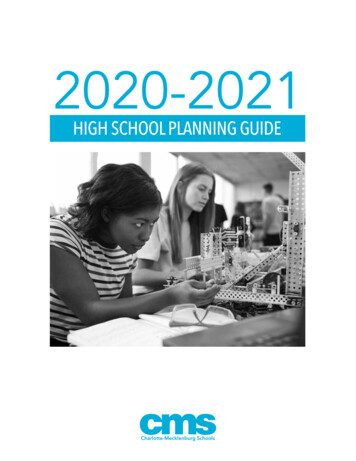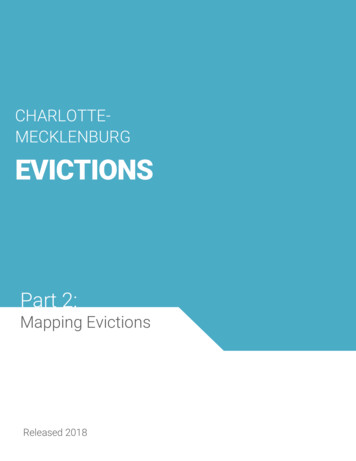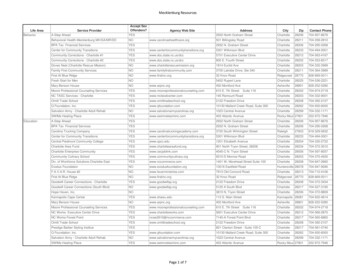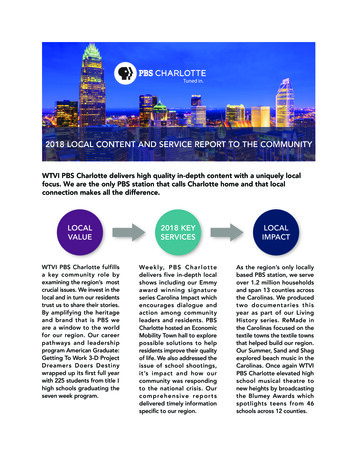
Transcription
Section 504Compliance GuidebookforGeneral Information forParents/GuardiansPROCEDURES AND FORMSFOR IDENTIFICATION, EVALUATION, AND PLACEMENT UNDERSECTION 504 OF THE REHABILITATION ACT of 19732020-2021
IntroductionSection 504 of the Rehabilitation Act of 1973, with its subsequent amendments, is a Federal civil rights lawthat prohibits discrimination against students with disabilities. Section 504 regulations require schooldistricts to provide appropriate education to students with disabilities. This handbook aids with theimplementation of Section 504 by the Charlotte-Mecklenburg Schools.Most forms are available in Spanish. Please contact the CMS Section 504 Department at 980-343-0001 ifother translations are needed.The information in this Guidebook includes the changes resulting from the Americans with DisabilitiesAct Amendments Act of 2008 and reflects the Charlotte-Mecklenburg Schools’ ongoing commitment toeducating ALL children in accordance with the CMS Board of Education’s vision and mission.This Guidebookwas g SchoolsSection 504 Compliance & Homebound Program Department(980-343-0001)Benjamin BenderRachel LongAmy CookDr. Harriett FordJennifer BlairLinda PowellManager, Section 504 Compliance ProgramSpecialist, Section 504/Homebound ProgramSpecialist, Section 504/Homebound ProgramSpecialist, Section 504/Homebound ProgramSpecialist, Section 504/Homebound ProgramProgram AssistantSection 504/Homebound -0072980-343-0070980-343-0069In compliance with Federal Law, Charlotte-Mecklenburg Schools administers all education programs, employment activities, and admissionswithout discrimination against any person on the basis of gender, race, color, religion, national origin, age, or disability. Inquiries regardingcompliance with Title IX of the Education Amendments of 1972, which prohibits discrimination on the basis of sex in education programs oractivities, may be referred to the District’s Title IX Coordinator at titleixcoordinator@cms.k12.nc.us or at http://www.cms.k12.nc.us/titleix,or to the Department for Civil Rights, United States Department of Education.2
Table of ContentsWhat is Section 504? . 5Relationship between Section 504 and the ADA/ADAAA . 5Section 504/ADAAA and the Individuals with Disabilities Education Improvement Act . 6Responsibilities of CMS under Section 504 . 6Locate and Identify . 6Conduct Child Find . 6Individual Healthcare Plan and Emergency Action Plan . 7Determine Eligibility under Section 504 . 8Definition of Evaluation under Section 504 . 8Physical or Mental Impairments . 8Substantial Limitation . 9Major Life Activities . 9Mitigating Measures. 9Impairments that are Episodic, in Remission, or Transitory/Temporary . 10Episodic Impairments . 10Impairments in Remission . 10Transitory/Temporary Impairments . 10Section 504 Plans . 10Students with Disabilities Who Do Not Need a Section 504 Plan . 11District-wide Information . 11Notice of Non-discrimination . 11Bullying/Harassment . 11Non-academic Services . 12Otherwise Qualified. 12Inclusion . 12Transfer Students . 12Student is New to CMS . 12Student Re-enrolls in CMS . 12Within-District Transfer. 13Service Animals. 13Use of Service Animals by Students with Disabilities . 13Section 504 Procedures . 15Step 1 — Referring a Concern . 15Step 2 — Preparing for the Section 504 Evaluation . 15Step 3 — Determining Eligibility under Section 504 . 15Step 4 — Developing a Section 504 Plan . 15Step 5 — Implementing the Section 504 Plan . 153
Step 6 — Monitoring Student Progress . 15School Psychologist Section 504 Evaluations . 16Related Services .17Hospital/Homebound Eligibility . 18Hospital/Homebound Placement: Procedures for Families. 18Accommodations and Testing Guidelines . 20Accommodations. 20Overview . 20Testing . 20Discipline and Section 504 Students . 21Manifestation Determination Review General Overview . 21Manifestation Determination Review Meeting . 21Appeal Rights and Placement during Appeals . 22Procedural Safeguards under Section 504. 23Notice . 23Opportunity to Review Records . 23A Review Procedure . 23Notice of Rights and Procedural Safeguards for Disabled Students and Their Parents under Section 504 . 26CMS Grievance Procedure . 26CMS Grievance Procedure - Level 1 . 27CMS Grievance Procedure - Level 2 . 27Guidelines for Section 504 Due Process Hearings . 28Selection of a Hearing Officer. 28Requesting a Hearing . 28Procedures Governing the Due Process Hearing . 28Failure to Appear for the Hearing . 28Decision of the Hearing Officer . 28Information List . 29Section 504 District Team: Contact Information . 30Charlotte-Mecklenburg Schools Board of Education Policy . 31Section 504 Guidebook Glossary . .33Concussions . 36Grievance Discrimination Complaint Document . 38Protecting Students with Disabilities: Frequently Asked Questions about Section 504 and the Education of Children withDisabilities. 394
The LawWhat is Section 504?“No otherwise qualified individual with a disability in the United States . shall, solely byreason of her or his disability, be excluded from participation in, be denied the benefits of,or be subjected to discrimination under any program or activity receiving Federal financialassistance ”29 U.S.C. § 794(a)Section 504 of the Rehabilitation Act of 1973, with its amendments, is a Federal law that was created toprotect the rights of individuals with disabilities in programs and activities that receive Federal financialassistance from the U.S. Department of Education (ED). “An important responsibility of the Office for CivilRights (OCR) is to eliminate discrimination on the basis of disability against students with disabilities.” “OCRenforces Section 504 in programs and activities that receive Federal financial assistance from ED. Recipientsof this Federal financial assistance includes public school districts, institutions of higher education, and otherstate and local education agencies.” OCR also enforces Title II of the Americans with Disabilities Act of 1990(ADA), reauthorized as the Americans with Disabilities Act Amendments Act (ADAAA) of 2008. Thisreauthorization, effective January 1, 2009, extends the prohibition against discrimination to the full range ofstate and local government services, programs, and activities (including public schools) regardless ofwhether they receive any Federal financial assistance. Section 504 requires that school districts provideFAPE to students in their jurisdiction who meet the definition of an individual with a disability under Section504. Denying a student with a disability a free and appropriate public education constitutes disabilitydiscrimination. (Protecting Students with Disabilities: FAQ About Section 504 and the Education of Childrenwith Disabilities , p. 2).A student has a disability under the Section 504 regulations if the student meets any one of the three prongsof eligibility listed in 34 C.F.R. 104.3(j)(2)(i). To be protected under Section 504, a student must bedetermined to:1) Have a physical or mental impairment that substantially limits one or more major life activities,2) Have a record of such an impairment, or3) Be regarded as having such an impairmentThe ADAAA did not change the actual language of the three prongs, but it did change how the various phrasesused in the three prongs are understood. Congress provided, as part of its rules of construction in the ADAAA,that the definition of disability in this Act shall be construed in favor of broad coverage of individuals underthis Act, to the maximum extent permitted by the terms of this Act, and to convey that identifying a qualifyingdisability should not demand extensive analysis. This statement should guide the school’s Section 504Team’s evaluation of the potentially eligible student. “The mere fact that a student has ‘a record of’ or is‘regarded as’ disabled is insufficient, in itself, to trigger those Section 504 protections that require theprovision of FAPE.” “The phrases ‘has a record of disability’ and ‘is regarded as disabled’ are meant toaddress the situation in which a student either does not currently have or never had a disability but is treatedby others as such.” (Protecting Students with Disabilities: FAQ About Section 504 and the Education ofChildren with Disabilities , Question 36).Relationship between Section 504 and the ADA/ADAAASection 504 and the ADA, amended in 2008 as the ADA Amendments Act, draw on a common definition ofdisability. Both laws share common eligibility language and a civil rights approach to disability5
discrimination. The ADAAA is a parallel statute to Section 504, and compliance with Section 504 in schoolsis the same as compliance with the ADAAA. Virtually every violation of Section 504 is also a violation of theADAAA in the educational arena. If a complainant alleges that the District has violated one statute, OCR willlikely investigate for violations of the other statute. The primary difference between these laws is thatSection 504 applies only to organizations, programs, and activities that receive Federal funding, whereas theADAAA applies to the full spectrum of state and local government agencies, programs, and activitiesregardless of whether they receive any Federal financial assistance.Section 504/ADAAA and the Individuals with Disabilities Education ImprovementActEligibility for protections and services under Section 504 is not the same as eligibility under the Individualswith Disabilities Education Act (IDEA), re-authorized in 2004 as the Individuals with Disabilities EducationImprovement Act (IDEIA), and later amended in 2015 through the Every Student Succeeds Act (ESSA).Section 504 provides protection from discrimination for students with disabilities in a general educationsetting who do not need specially designed instruction. Students covered under IDEIA with an IndividualizedEducation Program (IEP) do not need a separate Section 504 Plan, because students who are covered underIDEIA must have an IEP that addresses both specially designed instruction and any accommodations thatwould be provided under Section 504. If a student is eligible under the IDEIA, that student must has an IEP.Responsibilities of CMS under Section 504In this Guidebook, the term “parent” includes guardians and others with the authority to act on behalf of and in theinterest of a student.Under Section 504, school districts have a responsibility to locate, identify, evaluate, and place individuals whoare, or are believed to be, in need of regular or special education and related aids and services designed to meet thestudent’s educational needs as adequately as the needs of nondisabled students are met. Recipient school districtsare required to establish and implement procedural safeguards that include notice, an opportunity for parents toreview relevant records, a grievance process that includes a right to an impartial hearing and a review procedure,and a right to retain legal counsel. In addition, Section 504 requires districts to provide notice to parents explainingany evaluation and placement decisions affecting their children and explaining the parents’ right to revieweducational records and appeal any decision regarding evaluation and placement through an impartial hearing.Locate and IdentifyConduct Child FindCharlotte-Mecklenburg Schools shall endeavor to locate and identify every individual within the district, who is notreceiving a free appropriate public education due to having an unidentified physical or mental impairment thatsubstantially limits one or more major life activities. As such, district and school-based Section 504 staff engage inongoing Child Find activities. District initiatives may include, but are not limited to, providing information to parents,presenting information at school staff meetings, disseminating Child Find information in CMS schools and districtoffices, and reviewing student information received in the district office. In addition to district-based initiatives,individual schools employ school-based procedures to assist in the identification of students with a suspecteddisability. Teachers and other staff are obligated to notify the school-based Section 504 Coordinator if they suspectthat a student may benefit from an evaluation to determine if additional support may be needed. School-basedprocedures may include a review of student information upon registration, student absences, academic progress orlack thereof, incident reports due to ongoing behavioral challenges, students who have health concerns, and studentswho have been exited from special education/EC programs.6
Individual Healthcare Plan and Emergency Action PlanSchool staff must be aware of the relationship between Section 504 and an Individual Healthcare Plan (IHP) orEmergency Action Plan (EAP), and other similar plans such as those for asthma, seizures, and diabetic care. An IHPor an EAP is developed by the school nurse in collaboration with parents and relevant school staff. For students whohave an IHP or EAP but no Section 504 Plan, schools must consider whether students with either of these plans orother similar plans might be eligible under Section 504. At the 504 meeting, it is important to include the schoolnurse and, at times, the school psychologist. These individuals bring a unique perspective to the needs of thesestudents and their medical and/or mental health condition(s).1. If a student is currently covered under Section 504 and later presents the need for an IHP or EAP, the IHPor EAP should be developed under Section 504 regulations for evaluation and placement, and theparent/guardian is provided with a copy of the procedural safeguards under Section 504.2. If a student has an IHP or EAP but has not been evaluated for eligibility under Section 504, the parentsmust be offered a Section 504 meeting to determine eligibility. Based on a variety of data sources, if astudent with an IHP or EAP is suspected of having a physical or mental impairment that is substantiallylimiting one or more major life activities, then the student must be evaluated in accordance with Section504 regulations.3. A substantial limitation in any major life activity caused by a physical or mental impairment results inSection 504 coverage. In determining whether a student is or might be eligible under Section 504, it isinappropriate to limit the major life activities to learning or academic needs. This is a Section 504 Teamdecision and should not be made unilaterally.Example: A student with an IHP for asthma is referred for a Section 504 evaluation. The schooldistrict refuses to hold an evaluation review, because the student is proficient in reading andmath. This would violate Section 504’s evaluation regulations.4. The decision about whether a student with an IHP or EAP is eligible under Section 504 is determinedwithout regard to the positive effects of mitigating measures used by the student (the only exception tothis is ordinary eyeglasses or contact lenses). If a student would be substantially limited in one or moremajor life activities without the use of a mitigating measure, the student is eligible under Section 504, nomatter how well the mitigating measure works.Example: A student with an IHP who uses a hearing aid is referred for a Section 504 evaluation.The evaluation team considers the student’s limitations without the use of the hearing aid. Theevaluation team’s approach is correct, as they did not consider how the student performs withthe use of the hearing aid.5. Please note that the United States Department of Education considers IHPs and EAPs to be mitigatingmeasures. In determining whether a student with an IHP or EAP is eligible under Section 504, the Section504 evaluation team must determine the student’s limitations without the benefit of the IHP or EAP.Example: A student has an IHP for a severe nut allergy. The student has had several exposuresto allergens requiring the use of the IHP’s strategies during the school year. The Section 504evaluation team considers whether the student’s impairment without regard to the IHPsubstantially limits one or more major life activities. The Section 504 evaluation team’sapproach is correct.It is important to determine on an individual basis whether a student with an IHP or EAP has a physical or mentalimpairment that substantially limits a major life activity. It is incorrect to conclude that a student is Section 5047
eligible simply based on a diagnosis. There is no diagnosis or impairment that automatically warrants Section 504eligibility without linkage to a substantial limitation of a major life activity.Example: A student has a medication administration plan to address asthma. School officialssay, “Asthma? Say no more. This student is eligible under Section 504 and requires a plan.”This action is incorrect, because it neglects the individual analysis of whether the student’simpairment substantially limits one or more major life activities.Determine Eligibility under Section 504Definition of Evaluation under Section 504The Section 504 regulatory provision at 34 C.F.R. 104.35(b) requires school districts to individually evaluate astudent before classifying the student as having a disability or providing the student with special education. Whenconsidering an individual student’s eligibility, the term “evaluation” as it applies to Section 504 means to reviewinformation from a variety of sources and, if needed, obtain any additional info
Charlotte-Mecklenburg Schools shall endeavor to locate and identify every individual within the district, who is not receiving a free appropriate public education due to having an unidentified physical or mental impairment that substantially limits one or more major life activities. As such, district and school-based Section 504 staff engage in









![Mecklenburg College Annual Catalogue [1963-1964]](/img/32/mecklenburgcolle159carv.jpg)
